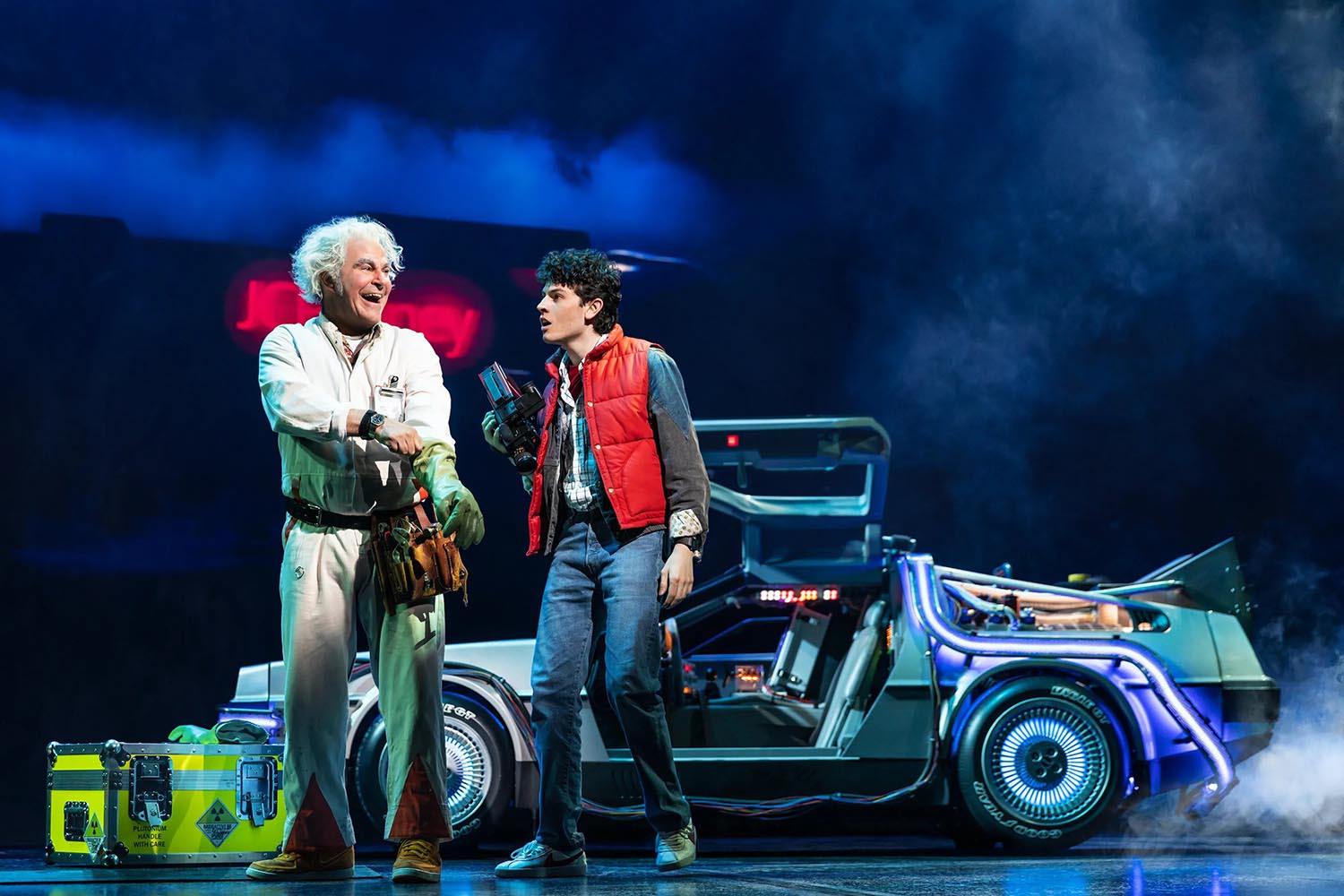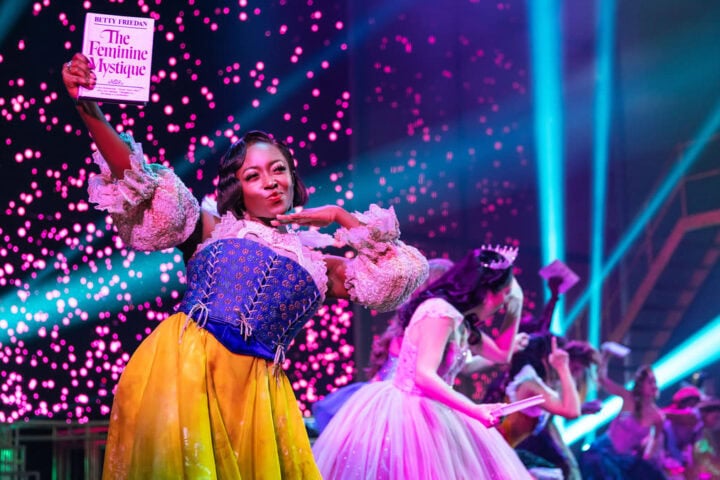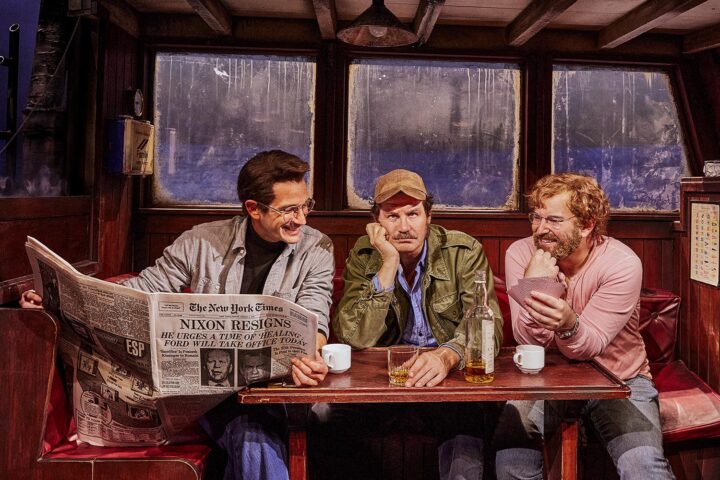If you’re seeing an eight p.m. performance of Back to the Future: The Musical on Broadway, I’ve got a time-travel tip for you: Set your DeLorean for about 10:10 p.m. and hit the gas, because it’s only in the final action sequence that this meandering remodeling of Robert Zemeckis’s 1985 sci-fi classic pivots from tedious fan service to stunning stage magic.
Few shows have mastered the varied arts of cinematic recreation quite like this one. Finn Ross’s video design brings the film’s iconic scenes of warp-speed time travel to thrilling life, while lit for maximal dizzying impact by Tim Lutkin and Hugh Vanstone. The reenactment of the moment when scientist Doc Brown (Roger Bart) clambers atop a clock tower during a lightning storm while Marty McFly (Casey Likes) revs the DeLorean in the distance is a perfect marriage of design elements, with video, lighting, and Tim Hatley’s rapidly transforming set integrating into a convincing whole that’s difficult to isolate into its parts.
But only the most adoring fans of the Back to the Future series will find similar wonder in the hours that lead up to this theatrical climax. As rendered by three luminaries with minimal previous theater experience—the book is by the film’s co-screenwriter Bob Gale and the music and lyrics are by the film’s composer Alan Silvestri and pop-rock songwriter Glen Ballard—the script and score reveal almost immediately that successful musical theater writing is far more complex than doing a screenplay on stage and dotting it periodically with songs. (Ballard’s previous theater credit is the ill-fated Broadway adaptation of Ghost.)
It’s not exactly rocket science—let alone the kind of physics needed to break through the time-space continuum—to identify the problem here. Zemeckis’s original film runs like clockwork, each moment serving to propel Marty’s life-or-death adventure—because there’s no time to lose. But Ballard and Silvestri use their songs again and again to bring the momentum to a thudding halt. Some stories lend themselves to contemplative pauses or celebratory timeouts, but this isn’t one of them: Almost every instance that characters start singing, there’s a sense that they really ought to be doing something else given the stakes and the deadline.
The stake, of course, is Marty’s very existence, such as it is in his stultifyingly dull household in 1985. After the teenaged Marty accidentally deploys Doc’s time-traveling invention to visit 1955, he almost immediately interrupts the moment when his parents, the feeble George (Hugh Coles) and libidinous Lorraine (Liana Hunt), first met. If he can’t get them to kiss at the Enchantment Under the Sea school dance, with the help of a much-younger Doc, he’ll never be born. Problem is that Lorraine has fallen head over heels for the new guy in town: Marty.
This quest—get Mom and Dad together, dodge Mom’s seductions, and escape, well, back to the future—doesn’t open up too many easy opportunities for song-and-dance breaks. That doesn’t stop the show from trying, and most of the attempts, like a gospel-infused showpiece for a waiter (Jelani Remy) whom Marty knows will become the town’s first Black mayor in the future, and a redundant trio for the nasty bullies, divert the show from its straight-shot storyline.
The exception is “Put Your Mind to It,” a rock number in which Marty instructs the hopelessly hapless George on how to be cool enough to win Lorraine’s heart. It’s hardly an inspired song, musically or lyrically speaking, but it actually moves Marty’s mission forward. By the end of the number, George has come out of his shell, so we believe that he might just have a fighting chance—and Coles, doing the nearest thing to an impression from the first film, is especially delightful at choreographically reimagining Crispin Glover’s on-screen stuttering physicality.

The 21-year-old Likes, with his boyish rock tenor and dopily confident grin, is the best human element about this Back to the Future, even if, as in Almost Famous, which he starred in last season, he doesn’t quite transcend the music with which he’s been saddled. Affably addled by his unusual circumstances—especially the revelation that his mother “has the hots” for him—Marty remains a fun protagonist to follow when he’s not trapped in song.
Doc is just the kind of kooky, outsized role that Bart has cultivated over the past 20 years, the logical successor to his previous turn as a mad scientist in Young Frankenstein and multiple madcap roles over The Producers’s run. Likes and Bart develop an endearingly daffy rapport across this musical, but Doc brings out the weakest efforts from Silvestri and Ballard’s songsmithing. Doc stops the show—in the wrong kind of way—to deliver an impenetrably vague rock treatise on time travel (“It Works”), to envision Marty’s return to the ’80s (“Future Boy”), and to muse on what the far future will hold in store (“21st Century”).
And almost as soon as Doc starts singing each time, an ensemble of bedazzled backup dancers, sometimes wearing top hats, white tie, and tails—and kicklining—show up to distract the audience from how little substance each lyric contains and how faintly each number adds to our understanding of this eccentric character. An honest attempt is made to deepen Doc late in the show through “For the Dreamers,” but the ballad is mostly notable for its sappiness.
But if the score suffers from half-hearted pastiche (of both ’50s and ’80s music) and the occasional disastrous lyric (“My myopia/Is my utopia/And I’m hopin’ ya/Feel it too,” croons George while spying on Lorraine from a nearby tree with his binoculars), it’s a boon, especially in the most cinematically soaring moments of stagecraft, that the team takes full advantage of Silvestri’s original instrumental score for Zemeckis’s film. These suspenseful orchestral interludes suggest that a non-singing, more faithful stage recreation of Back to the Future might have been significantly more effective. (Four songs from the film soundtrack show up too: a pair written by Huey Lewis for the movie, “Back in Time” and “The Power of Love,” alongside two popular ’50s tunes, “Earth Angel” and “Johnny B. Goode.”)
The show flattens the film’s already shaky commentary on gender dynamics, with Marty’s girlfriend, Jennifer (Mikaela Secada), now a crooning cypher who doesn’t even get to join Marty and Doc in the car as in the film’s farewell sequel-promising shot. A welcome-to-the-’50s number in which the Hill Valley denizens celebrate the brand new frontier of super-leaded gasoline, asbestos, DDT, and cigarettes culminates in a lazily sarcastic gesture toward addressing the social inequities of either of the show’s eras: “It just feels right when/All of these white men/Get to have their cake,” the ensemble sings, “So let the women bake.” (The film’s mocking depiction of Libyans has thankfully been excised.)
But staged electrifyingly as it is, by veteran musical theater director John Rando, that culminating scene at the clock tower is possibly worth a couple hours of annoyance, if not the couple hundred dollars for a ticket. I’d consider traveling back to the Winter Garden Theatre just to take another peep at those eight or so minutes of sheer theatrical achievement.
Back to the Future is now running at the Marquis Theater.
Since 2001, we've brought you uncompromising, candid takes on the world of film, music, television, video games, theater, and more. Independently owned and operated publications like Slant have been hit hard in recent years, but we’re committed to keeping our content free and accessible—meaning no paywalls or fees.
If you like what we do, please consider subscribing to our Patreon or making a donation.





